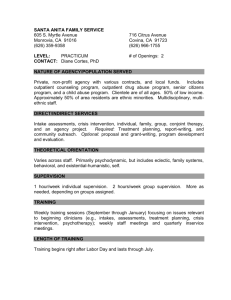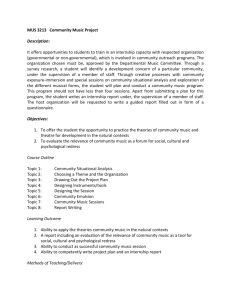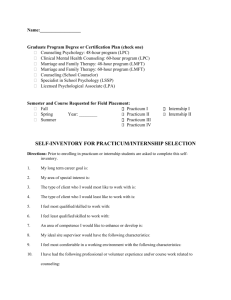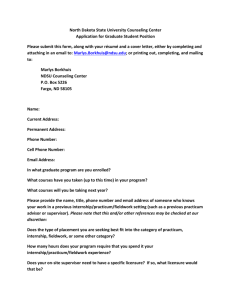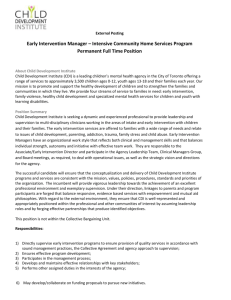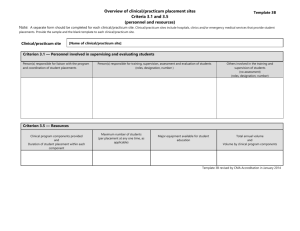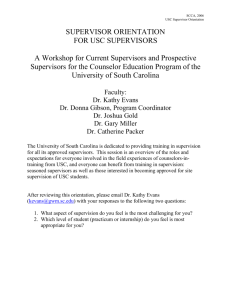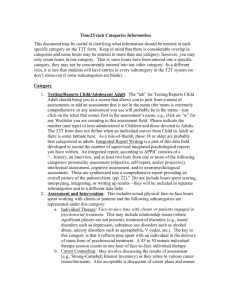Guidelines for Tracking Clinical Hours Department of Psychology
advertisement
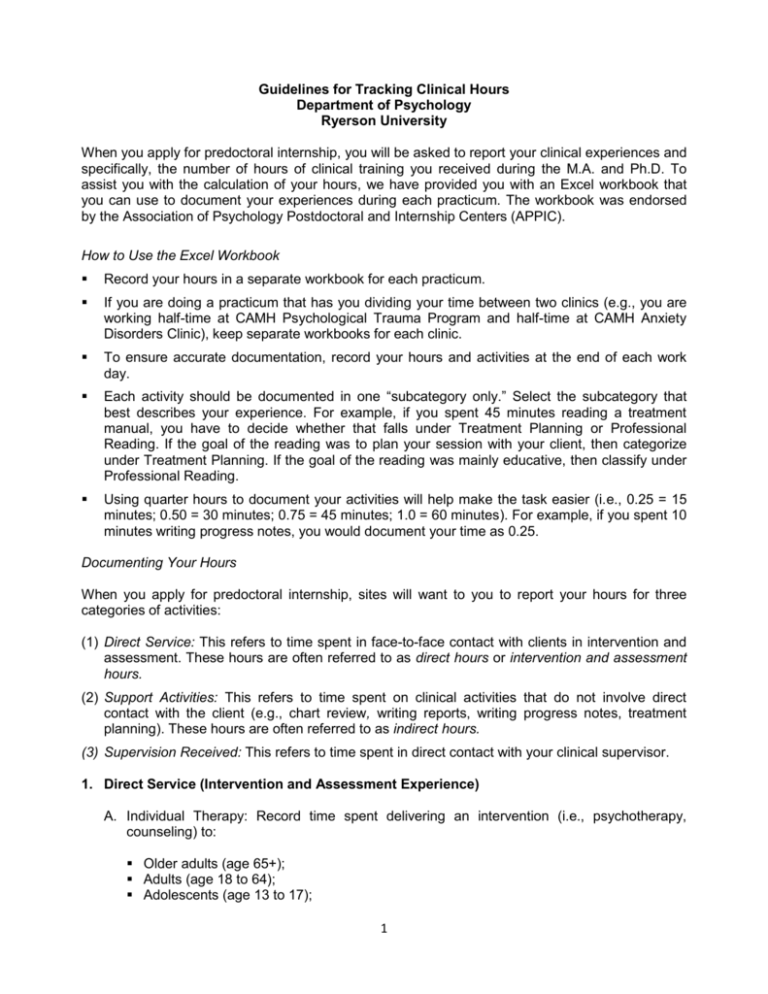
Guidelines for Tracking Clinical Hours Department of Psychology Ryerson University When you apply for predoctoral internship, you will be asked to report your clinical experiences and specifically, the number of hours of clinical training you received during the M.A. and Ph.D. To assist you with the calculation of your hours, we have provided you with an Excel workbook that you can use to document your experiences during each practicum. The workbook was endorsed by the Association of Psychology Postdoctoral and Internship Centers (APPIC). How to Use the Excel Workbook Record your hours in a separate workbook for each practicum. If you are doing a practicum that has you dividing your time between two clinics (e.g., you are working half-time at CAMH Psychological Trauma Program and half-time at CAMH Anxiety Disorders Clinic), keep separate workbooks for each clinic. To ensure accurate documentation, record your hours and activities at the end of each work day. Each activity should be documented in one “subcategory only.” Select the subcategory that best describes your experience. For example, if you spent 45 minutes reading a treatment manual, you have to decide whether that falls under Treatment Planning or Professional Reading. If the goal of the reading was to plan your session with your client, then categorize under Treatment Planning. If the goal of the reading was mainly educative, then classify under Professional Reading. Using quarter hours to document your activities will help make the task easier (i.e., 0.25 = 15 minutes; 0.50 = 30 minutes; 0.75 = 45 minutes; 1.0 = 60 minutes). For example, if you spent 10 minutes writing progress notes, you would document your time as 0.25. Documenting Your Hours When you apply for predoctoral internship, sites will want to you to report your hours for three categories of activities: (1) Direct Service: This refers to time spent in face-to-face contact with clients in intervention and assessment. These hours are often referred to as direct hours or intervention and assessment hours. (2) Support Activities: This refers to time spent on clinical activities that do not involve direct contact with the client (e.g., chart review, writing reports, writing progress notes, treatment planning). These hours are often referred to as indirect hours. (3) Supervision Received: This refers to time spent in direct contact with your clinical supervisor. 1. Direct Service (Intervention and Assessment Experience) A. Individual Therapy: Record time spent delivering an intervention (i.e., psychotherapy, counseling) to: Older adults (age 65+); Adults (age 18 to 64); Adolescents (age 13 to 17); 1 School-age children (age 6 to 12); Pre-school age children (age 3 to 5); Infants/toddlers (age 0 to 2) B. Career Counseling: Most of you will not be doing career counseling during your training. C. Group Counseling: Time spent leading or co-leading group treatments. Groups can have an open (i.e., drop-in) or closed membership. Note that for the purposes of documentation, a group should be thought of as a “unit”. Suppose you are leading a 2-hour weekly group treatment for panic disorder and the group consists of 12 clients. The number of intervention hours per week = 2 hours, regardless of the number of clients in your group. Record group treatment hours for: Adults (age 18 +) Adolescents (age 13 to 17) Children (age 12 and under) D. Family Therapy: Time spent delivering an intervention (i.e., psychotherapy, counseling) to a family The guideline for recording hours for group therapy applies to family therapy E. Couple Therapy: Time spent delivering an intervention (i.e., psychotherapy, counseling) to a couple. The guideline for recording hours for group therapy applies to couple therapy. F. School Counseling Interventions: delivering assessment and intervention services (i.e., psychotherapy, counseling) in school settings. G. Other Psychological Interventions: Time spent in the following activities: Sport Psychology / Performance Enhancement Medical / Health-Related Interventions Intake Interview / Structured Interview: refers to the administration of clinical or diagnostic interviews (e.g., SCID-I, ADIS-IV). The interviews may be structured or semistructured. Substance Abuse Interventions Telephone Interventions Other Interventions H. Psychological Assessment Experience: Time spent administering a psychological instrument to a client. Hours spent on scoring, interpretation, provision of feedback to clients, and report writing are recorded under Support Activities. Do not count the practice assessments you conducted with other graduate students as part of your assessment course. Psychodiagnostic Test Administration: Includes symptom inventories (e.g., BDI-II), projective tests (e.g., TAT), personality assessments (e.g., MMPI-2, Millon), intellectual assessment (e.g., WAIS-III, WAIS-IV) 2 Neuropsychological Assessment: If the intellectual assessment was carried out as part of a neuropsychological assessment, include it in this subcategory, not as part of psychodiagnostic test administration Assessment feedback session: communication of assessment findings to a client. Note: In a separate worksheet in your workbook, keep track of the specific tests you administered including the number administered (e.g., 3 WAIS-IV, 10 BDI-II) Note: Internship sites will ask you about the number of Integrated Reports you have written during your training. This refers to a comprehensive report that includes the following elements: the client’s history, findings from a clinical interview, and at least 2 of the following measures (the measures can be of the same “type”): Objective personality test (e.g., MMPI-2) Projective personality test (e.g., TAT) Cognitive assessments/measures Neuropsychological measures Symptom measures In addition to the time spent in face-to-face contact with clients, internship sites will also want information on the types of clients you have had experience with. For every client you see in intervention and assessment, keep a record of the following information (taken directly from the APPI form; see APPIC website). Document this information on a separate sheet in the Excel workbook you are using to track your hours. Race/Ethnicity # of clients seen for Intervention # of clients seen for Assessment # of clients seen for Intervention # of clients seen for Assessment # of clients seen for Intervention # of clients seen for Assessment African-American/ Black/ African Origin Asian/American / Asian Origin / Pacific Islander Latino (a) / Hispanic American Indian / Alaska Native / Aboriginal Canadian European Origin / White Bi-racial / Multi- Racial Other (specify) Sexual Orientation (document only when known) Heterosexual Gay Lesbian Bisexual Other (specify): Disabilities Physical/Orthopedic Disability Blind/ Visually Impaired Deaf/Hard of Hearing Learning/ Cognitive Disability Developmental Disability (including Mental Retardation, Autism) 3 Serious Mental Illness (e.g., primary psychotic disorders, major mood disorders that significantly interfere with adaptive functioning Gender # of clients seen for Intervention # of clients seen for Assessment Male Female Transgendered In addition to the information above, you should also record religious affiliation for each client (if known). I. Other Psychological Experience with Students and/or Organizations Supervision of other students performing intervention and assessment activities. Note that the supervisee must be at a less advanced level (e.g., Ph.D. student providing supervision to a M.A. student). Note that peer supervision is not documented in this section. Program Development/Outreach: Outcome Assessment of Programs or Projects: Any research on clinical services at your practicum site (e.g., research on client satisfaction with clinical services) Systems Intervention/Consultation: Provision of specialized consultation or training to members of an agency or institution with a location that is external to your practicum site (e.g., a workplace, a school). 2. Support Activities A. Client Support Activities: Time spent in activities that pertain directly to your clients, but that do not involve direct client contact. Progress notes Report writing Consultation: discussions with individuals who are not your supervisor. The specific goal of the consultation is to solve a problem related to a client or improve client care. For example, you suspect that your client may benefit from an anti-depressant and you consult with the team psychiatrist to obtain more information. Treatment planning / Preparing for your treatment sessions Chart / File Review Scoring Assessment Interpreting Assessment Paperwork Treatment Discharge / Termination Writing a referral Video / Audiotape Review of Session 4 B. Other Support Activities: Time spent in clinical activities that are not specific to your clients. Didactic Training / Seminars: This refers to grand rounds, seminars, workshops, conferences that you participated in at the practicum site. Professional Reading: Reading related to your work on practicum (e.g., treatment manuals, test manuals, research articles related to your client population) Supervision of Other Students: Program Development/Outreach Outcome Assessment Systems Intervention / Organizational Consultation Hours documentation 3. Supervision Received: Time spent in supervision meetings with your clinical supervisor. The clinical supervisor is a licensed psychologist, or a psychologist in supervised practice who oversees your work as a trainee (i.e., signs your progress notes and reports, conducts a formal evaluation of your work) One-on-one hours: time spent in face-to-face, individual supervision Review of audio/video tape: time spent listening or viewing tapes in supervision meetings. Group supervision: supervision meetings with your clinical supervisor that also include other trainees (psychology students, social work students, medical students, etc.). For example, if you and your supervision group meet for 2 hours during a given week and you spend 15 minutes discussing your client during supervision, supervision time still = 2 hours. 5
